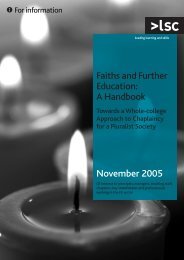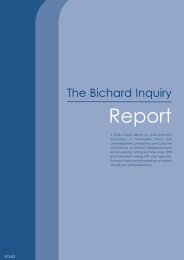Recognising and recording progress and achievement in non ...
Recognising and recording progress and achievement in non ...
Recognising and recording progress and achievement in non ...
You also want an ePaper? Increase the reach of your titles
YUMPU automatically turns print PDFs into web optimized ePapers that Google loves.
<strong>Recognis<strong>in</strong>g</strong> <strong>and</strong> Record<strong>in</strong>g Progress <strong>and</strong> Achievement <strong>in</strong> Non-accredited Learn<strong>in</strong>glearn<strong>in</strong>g opportunities are offered <strong>in</strong> the furthereducation sector, where they are currently fundedas ‘other provision’. Non-accredited learn<strong>in</strong>g is alsooffered by adult <strong>and</strong> community learn<strong>in</strong>g <strong>and</strong> voluntarysector providers; through partners of providers;through workforce development; E2E programmes;through UfI/learndirect; <strong>and</strong> <strong>in</strong> specialist collegesfor learners with learn<strong>in</strong>g difficulties <strong>and</strong>/or disabilities.BackgroundSuccess for All9 The learn<strong>in</strong>g <strong>and</strong> skills sector has a vital roleto play <strong>in</strong> creat<strong>in</strong>g a well-qualified <strong>and</strong> highly skilledpopulation, <strong>and</strong> <strong>in</strong> encourag<strong>in</strong>g a cultureof lifelong learn<strong>in</strong>g.10 Success for All is the long-term reform strategyto develop the high-quality, dem<strong>and</strong>-led, responsivecolleges <strong>and</strong> providers we need <strong>in</strong> the learn<strong>in</strong>g<strong>and</strong> skills sector.11 Success for All was launched <strong>in</strong> November 2002.It has five ma<strong>in</strong> themes:• meet<strong>in</strong>g needs <strong>and</strong> improv<strong>in</strong>g choice• putt<strong>in</strong>g teach<strong>in</strong>g, tra<strong>in</strong><strong>in</strong>g <strong>and</strong> learn<strong>in</strong>gat the heart of what we do• develop<strong>in</strong>g the leaders, teachers, tra<strong>in</strong>ers<strong>and</strong> support staff of the future• develop<strong>in</strong>g a framework for quality <strong>and</strong> success• accelerat<strong>in</strong>g quality improvement.12 RARPA contributes to the fourth <strong>and</strong> fifth themes.More <strong>in</strong>formation can be found at the Success for Allwebsite (www.dfes.gov.uk/successforall/<strong>in</strong>dex.cfm).New measures13 The LSC has been work<strong>in</strong>g with the Departmentfor Education <strong>and</strong> Skills (DfES), the Office for St<strong>and</strong>ards<strong>in</strong> Education (Ofsted) <strong>and</strong> the Adult Learn<strong>in</strong>gInspectorate (ALI) to develop a broad <strong>and</strong> coherentset of measures that can properly recognise<strong>and</strong> celebrate learners’ <strong>achievement</strong>s acrossthe learn<strong>in</strong>g <strong>and</strong> skills sector, <strong>and</strong> measurethe success of providers.14 The purpose of the new measures is to improvethe ways <strong>in</strong> which we make judgements about success<strong>in</strong> the sector <strong>and</strong> ensure that we focus on what reallymatters, which is to provide excellent teach<strong>in</strong>g <strong>and</strong>learn<strong>in</strong>g for learners, local communities <strong>and</strong> employers.15 The National Institute of Adult Cont<strong>in</strong>u<strong>in</strong>gEducation (NIACE) <strong>and</strong> the Learn<strong>in</strong>g <strong>and</strong> SkillsDevelopment Agency (LSDA) have recently evaluatedthe work of pilot<strong>in</strong>g RARPA <strong>in</strong> <strong>non</strong>-accredited provision.The evaluation reveals that the RARPA approachis widely accepted as a model of effective practice<strong>in</strong> teach<strong>in</strong>g <strong>and</strong> learn<strong>in</strong>g. It can also enhance exist<strong>in</strong>gquality assurance arrangements with<strong>in</strong> <strong>in</strong>stitutions,without creat<strong>in</strong>g additional bureaucracy.16 The LSC is now consider<strong>in</strong>g extend<strong>in</strong>g the RARPAapproach <strong>in</strong> order to measure distance travelledfor learners who are outside the scope of the statisticalmethods be<strong>in</strong>g developed for 16-19 year olds.The RARPA extension project (REX) will take this workforward. More <strong>in</strong>formation about REX is available<strong>in</strong> New Measures of Success Quality InformationPack, available on the LSC website from July 2005.Mix <strong>and</strong> balance of provision17 The LSC is keen to work <strong>in</strong> partnership withall learn<strong>in</strong>g providers <strong>in</strong> develop<strong>in</strong>g local, regional<strong>and</strong> national strategies for manag<strong>in</strong>g the mix<strong>and</strong> balance of provision <strong>in</strong> the learn<strong>in</strong>g <strong>and</strong> skillssector <strong>in</strong> order to ensure that priorities <strong>and</strong> targetsare met.18 The LSC has a duty to secure proper<strong>and</strong> reasonable provision to meet the needsof all learners. In practice, this means achiev<strong>in</strong>gan appropriate balance between provision thatdirectly contributes to the LSC’s Public ServiceAgreement (PSA) targets <strong>and</strong> identified priorities,<strong>and</strong> provision that <strong>in</strong>directly supports its targets<strong>and</strong> priorities through learner <strong>achievement</strong><strong>and</strong> <strong>progress</strong>ion. In achiev<strong>in</strong>g this balance, local LSCswill need to ensure that, <strong>in</strong> addition to target-bear<strong>in</strong>gprovision, due account is taken of what learners<strong>and</strong> employers both want <strong>and</strong> need, <strong>in</strong>clud<strong>in</strong>gsufficient provision that:• encourages young people <strong>and</strong> adults back<strong>in</strong>to learn<strong>in</strong>g or acts as a stepp<strong>in</strong>g-stone <strong>in</strong>tofurther learn<strong>in</strong>g, lead<strong>in</strong>g to qualificationsor units of qualifications• at Level 3 <strong>and</strong> above, is l<strong>in</strong>ked to regional skillspriorities <strong>and</strong> <strong>in</strong>dividual learner need.19 This may <strong>in</strong>clude a proportion of learn<strong>in</strong>g activitydef<strong>in</strong>ed as ‘other provision’ <strong>and</strong> which may be either<strong>in</strong>ternally certificated (that is, <strong>non</strong>-accredited)or externally certificated awards <strong>and</strong> qualificationswhich are outside the National QualificationFramework (NQF).2
















